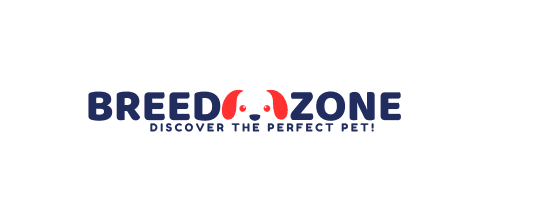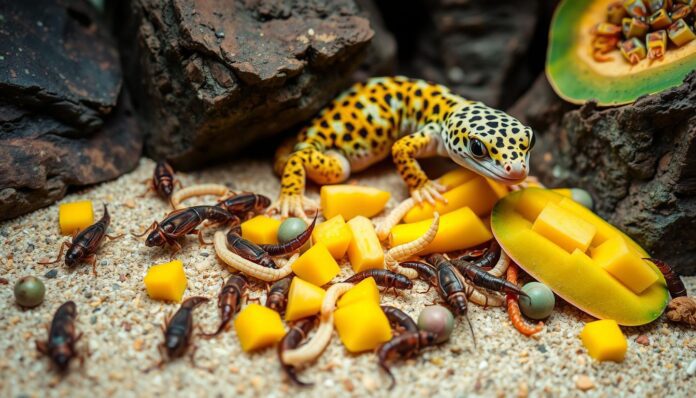Did you know a single leopard gecko can eat up to 100 crickets at once? This shows how important it is to know what they should eat. Leopard geckos need a diet of live insects to stay healthy and live long lives. This guide will cover the best foods for them, how often to feed, and what supplements they need.
Understanding Leopard Gecko’s Natural Diet
Leopard geckos are fascinating creatures from South-eastern Asia’s dry lands. They eat only insects, showing how they’ve adapted to their environment. Knowing this is key to caring for them in captivity.
In the wild, they munch on crickets, mealworms, and waxworms. These insects are not just food; they’re essential for the gecko’s health. By learning about their natural diet, we can make sure our pets get the right food.
| Insect Feeder | Nutritional Value | Feeding Recommendation |
|---|---|---|
| Crickets | High in protein, moderate fat | Staple food, feed regularly |
| Mealworms | Moderate protein, high fat | Feed in moderation as a treat |
| Waxworms | Low protein, very high fat | Feed sparingly as an occasional treat |
By mimicking their leopard gecko’s natural diet, we can help our pets thrive. Understanding their insectivore’s natural feeding habits is vital for their care. It ensures they get the nutrients they need.
What Can Leopard Geckos Eat
Leopard geckos mainly eat insects. They can’t digest fruits, vegetables, or other foods not insects. Knowing what’s safe and healthy for them helps keep your pet happy and healthy.
Safe Insects for Daily Feeding
Leopard geckos love to eat crickets, mealworms, dubia roaches, and black soldier fly larvae. These insects are full of protein, fat, and other good stuff. Make sure to gut-load and calcium-dust them before feeding.
Treat Options and Special Foods
Geckos can have waxworms, butterworms, and small superworms as treats sometimes. But, these should be rare because they’re high in fat. Don’t feed them wild insects, lightning bugs, or fireflies because they’re toxic.
Foods to Avoid
Don’t give leopard geckos fruits, vegetables, or dead/dried insects. Their short digestive system can’t handle these. Also, meat or human food can cause obesity, digestive problems, and even death.
It’s important to have a varied feeder insects for leopard geckos diet. This ensures your pet gets all the nutrients they need. By choosing safe foods and avoiding bad ones, you keep your gecko healthy and happy.

Proper Feeding Schedule and Portions
It’s important to feed your leopard gecko regularly for their health. How often you feed them depends on their age. Young geckos, under one year, need food every day because they grow fast.
Black Bearded Dragon: Rare Beauty, Care Tips, and Fascinating Facts
As they get older, feeding them every other day or every three days is best. Adult geckos with thick tails can eat every five days.
For portion sizes, give 2 insects for each inch of your gecko’s length. Or, feed them as much as they can eat in 15 minutes. Don’t leave insects in their cage all day to avoid injuries.
| Age | Feeding Frequency | Portion Size |
|---|---|---|
| Juvenile (under 1 year) | Daily | 2 insects per inch of gecko length |
| Young Adult | Every other day or every 3 days | 2 insects per inch of gecko length |
| Adult (with tail thicker than neck) | Every 5 days | 2 insects per inch of gecko length |
By following this leopard gecko feeding guide, you can ensure your gecko gets the right food and portion sizes. Adjusting their feeding schedule and portion sizes as they grow is key to their health.
Essential Feeding Guidelines by Age
Feeding your leopard gecko right is key to their health and happiness. Knowing what to feed them at each stage helps them stay healthy and strong.
Baby Gecko Feeding Requirements
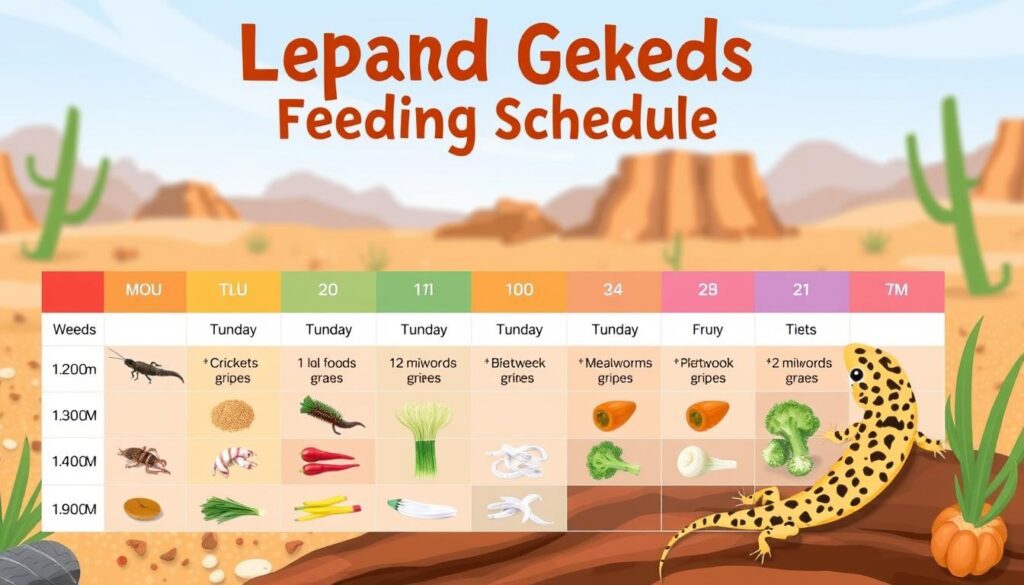
Baby leopard geckos, under 6 inches, need small, sized insects every day. Make sure the insects fit between their eyes. Feed them 2 insects for each inch of their length, so they can easily eat them.
Juvenile Gecko Nutrition
As they grow, feed them every other day. Give them gut-loaded insects with calcium and vitamins. Increase the size of the insects as they get bigger.
Adult Gecko Diet Management
Adult geckos eat every 2-3 days. Feed them a mix of insects like crickets, mealworms, and dubia roaches. Treats like waxworms or small pinky mice are okay, but not too often.
Always watch your gecko’s weight and adjust their food as needed. Good food, a nice home, and vet visits keep them happy and healthy for years.
Gut Loading: Enhancing Insect Nutrition
Feeding your leopard gecko a nutritious diet is key for its health. Gut loading is a part of this. It means giving insects a rich diet before you feed them to your gecko.
Gut loading makes insects more nutritious. This way, your gecko gets the best nutrition from its food. You can feed the insects fruits, veggies, and special gut-loading diets. This boosts the vitamins, minerals, and nutrients your gecko eats.
- Avoid feeding the insects acidic produce, spinach, or broccoli, as these can negatively impact their nutritional profile.
- Regularly change the insects’ food to prevent mold growth, which can be harmful to your gecko.
Proper gut loading is a simple yet effective way to boost the nutritional content of the gut loading insects you provide to your leopard gecko. This ensures your pet receives the essential insect nutrition it needs to thrive and maintain a healthy leopard gecko diet.
Vitamin and Mineral Supplementation
Keeping your leopard gecko healthy is key. A good diet and supplements are important. They help avoid diseases like metabolic bone disease.

Calcium Supplementation Guidelines
Calcium is vital for strong bones in leopard geckos. Dust their food with calcium powder 3-4 times a week. If they get UVB light, use calcium without vitamin D3. For others, choose a calcium with vitamin D3 to help absorb calcium.
Essential Vitamins for Health
- Give young geckos a multivitamin once a week. Adults can have it every other week. This ensures they get all the vitamins and minerals they need.
- Use vitamin A (retinol) supplements instead of beta-carotene. Leopard geckos can’t easily turn beta-carotene into vitamin A.
Proper Dusting Techniques
When dusting insects, just lightly coat them before feeding. This way, your gecko gets the most from the supplements.
| Supplement | Frequency | Purpose |
|---|---|---|
| Calcium (without D3) | 3-4 times per week | Supports bone health and metabolism |
| Calcium (with D3) | 1-2 times per week | Enhances calcium absorption |
| Multivitamin | 1 time per week for young geckos, 1 time every 2 weeks for adults | Provides a variety of essential vitamins and minerals |
By following these guidelines and dusting techniques, your leopard gecko will get the right calcium, vitamin supplements, and dusting insects. This ensures they stay healthy and live a long life.
Signs of Proper Nutrition and Healthy Feeding
A healthy leopard gecko shows several signs of good health. Its tail should be wider than its body but not too fat. The stomach should look flat, except right after eating. Look for clear, alert eyes, smooth skin, and regular shedding.
Healthy leopard geckos are active and love to eat. It’s important to check their weight often and adjust their food as needed. If their appetite or looks change suddenly, you should act fast to keep them healthy.
| Nutritional Sign | Healthy Appearance |
|---|---|
| Tail Width | Wider than the body, but not excessively fat |
| Stomach | Mostly flat, except right after feeding |
| Eyes | Clear and alert |
| Skin | Smooth and healthy |
| Shedding | Regular and consistent |
| Activity Level | Active and interested in food |
| Weight Monitoring | Adjusted feeding as needed |
By watching these nutritional signs and making sure they eat well, you can keep your leopard gecko healthy and happy.
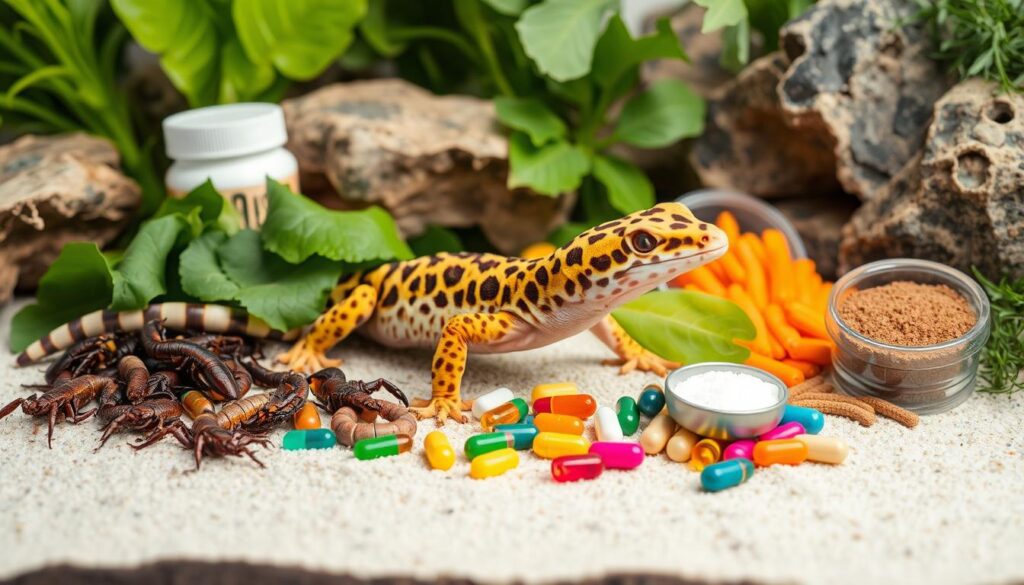
Common Feeding Mistakes to Avoid
Caring for a leopard gecko means paying close attention to their food. Even experienced owners can make mistakes that harm their gecko’s health. Let’s look at some common feeding errors and how to avoid them.
Overfeeding Issues
One big mistake is overfeeding. Giving too many insects or treats can cause obesity and health issues. It’s key to stick to the right feeding schedule and amounts for your gecko’s age and size. Young ones need food every day, while adults can go 3-4 days without eating.
Poor Supplement Management
Managing supplements is vital for your gecko’s diet. Skipping calcium and vitamin dust on insects can lead to diseases like metabolic bone disease. Keeping a regular supplement schedule and using the right products is important for your gecko’s health.
Incorrect Food Sizes
Feeding prey that’s too big can be dangerous. It can cause choking or digestive problems. Make sure to choose insects that are the right size for your gecko, no bigger than the space between their eyes.
By avoiding these leopard gecko feeding mistakes, you can give your pet a healthy diet. Paying attention to portion sizes, supplements, and the right prey size is key. This will help keep your gecko happy and healthy for a long time.
Hydration Requirements and Water Sources
Keeping leopard geckos hydrated is key to their health. They need clean, fresh water for digestion, shedding, and staying energetic.
Leopard geckos need a shallow water dish for soaking. It should be big enough for them to soak but not so deep they can drown. Make sure the dish is stable and won’t spill. Clean and refill the water daily for the best results.
Some leopard geckos might not drink from standing water. Mist or use a dripper system to help them stay hydrated. Keeping the enclosure’s humidity right, between 20% and 40% for adults, helps too. For babies and young geckos, aim for 50% to 70% humidity.
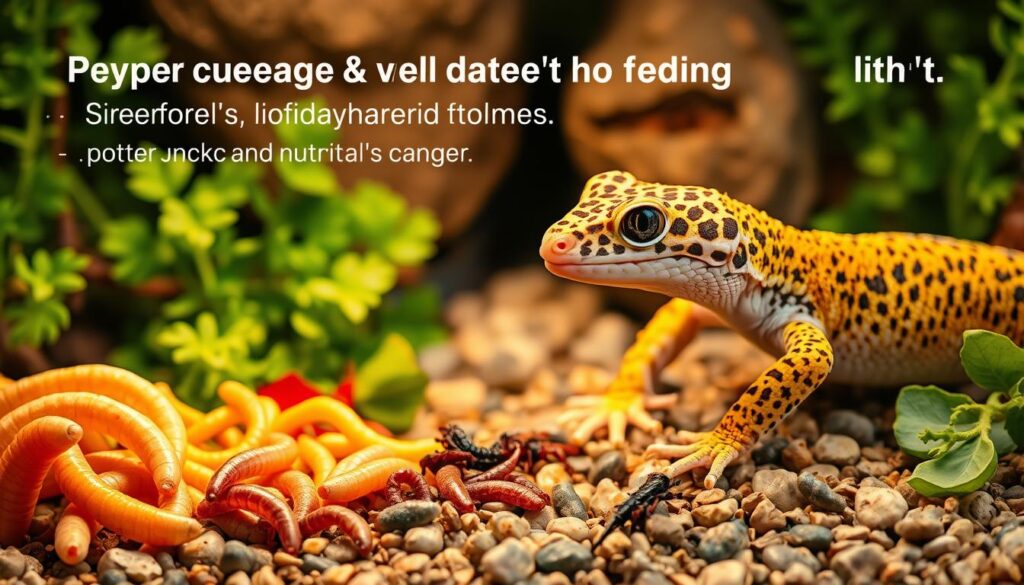
By giving them clean water and the right humidity, you keep your leopard gecko healthy. Hydration is vital for their body’s functions. Without enough water, they can get dehydrated quickly, in just 48 to 72 hours.
Managing Feeding Problems and Food Refusal
Leopard geckos can sometimes become picky eaters or refuse food altogether. This can worry pet owners. It’s important to understand why this happens to keep your gecko healthy.
Stress is a common reason for food refusal in leopard geckos. Incorrect tank temperature, lack of hiding spots, or too much handling can stress them out. A proper enclosure setup helps reduce stress and encourages eating.
Dehydration or illness can also make geckos lose their appetite. Look for signs like sunken eyes or wrinkled skin. If you think your gecko is sick, see a reptile vet. Healthy adult geckos can skip meals for up to two weeks, but fasting for too long is a problem.
If your gecko won’t eat, see a reptile vet to check for health issues. With patience and the right changes, you can help your gecko eat well again.
| Potential Reasons for Leopard Gecko Food Refusal | Recommended Solutions |
|---|---|
| Stress | Ensure proper enclosure setup, minimize handling |
| Dehydration | Check for signs of dehydration, provide adequate water sources |
| Illness | Consult a reptile veterinarian |
| Improper tank temperature | Maintain basking area around 89-91°F, cool end in mid-70s |
| Breeding season (females) | Adjust feeding schedule and dietary needs during this time |
By fixing the root causes and making the right changes, you can help your leopard gecko not eating. This will solve any feeding problems or food refusal they face.

Conclusion
Proper leopard gecko care and a well-planned feeding guide are key for their health and long life. Giving them a variety of insects, dusted with reptile nutrition supplements, is vital. This ensures they get the balanced diet they need.
It’s important to adjust feeding amounts and schedules based on the gecko’s age and health. Watching for signs of good nutrition and fixing any feeding problems is essential. This way, your leopard gecko can live a long and happy life in captivity.
With the right care, leopard geckos can live up to 20 years, much longer than their 6-8 years in the wild. Following the detailed advice in this article helps gecko lovers give their pets the best life. They can reach their full life span and stay healthy for years.
FAQ
What can leopard geckos eat?
Leopard geckos are insectivores. They need a diet of live insects. Good options are crickets, mealworms, dubia roaches, and black soldier fly larvae.
Treat foods like waxworms and butterworms should be given sparingly. This is because they have high fat content.
What should I avoid feeding leopard geckos?
Don’t feed them fruit, vegetables, wild-caught insects, lightning bugs, or fireflies. These can be toxic. Also, avoid dried or dead insects.
How often should I feed my leopard gecko?
Feeding frequency changes with age. Juveniles eat daily, young adults every other day or every three days. Adults with thick tails eat every five days.
Feed 2 insects per inch of length, or as much as they can eat in 15 minutes.
How do I ensure proper nutrition for my leopard gecko?
Gut loading insects with nutritious foods is key. Dust them with calcium and vitamin supplements. This ensures a balanced diet.
Proper supplementation prevents metabolic bone disease and other nutritional deficiencies.
What are the signs of a healthy, well-nourished leopard gecko?
A healthy leopard gecko has a tail wider than its body. It has a mostly flat stomach, clear alert eyes, and smooth skin.
They should be active and show interest in food. Regular shedding is also a sign of health.
How can I avoid common feeding mistakes with leopard geckos?
Avoid overfeeding and poor supplement management. Make sure to offer the right sized prey. Gut load and dust insects properly.
Use a variety of insects instead of relying on one type.
How can I keep my leopard gecko hydrated?
Leopard geckos need constant access to clean, fresh water. Use a shallow dish and clean and refill it daily.
Some geckos may also benefit from occasional misting or a dripper system.
What should I do if my leopard gecko stops eating?
Reasons for food refusal include incorrect tank temperature, stress, dehydration, or illness. Ensure proper enclosure conditions.
Check for signs of health issues. If refusal persists, consult a reptile veterinarian.

